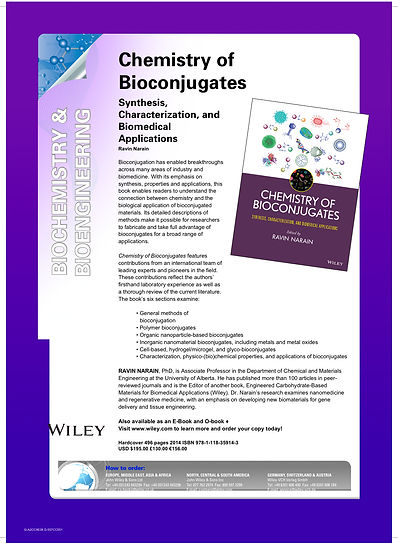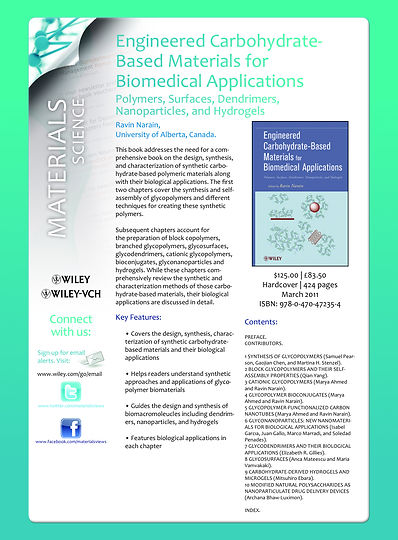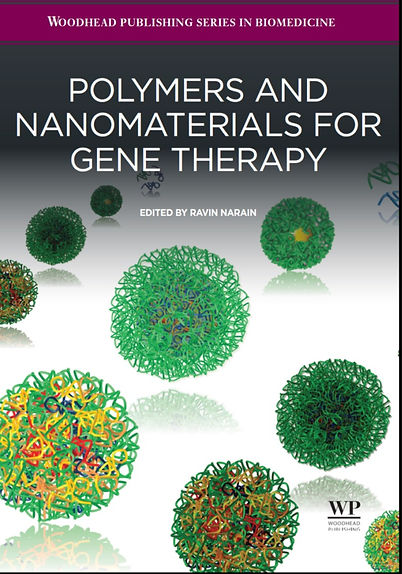NarainLaboratory
UNIVERSITY OF ALBERTA
Bioconjugation has enabled breakthroughs across many areas of industry and biomedicine. With its emphasis on synthesis, properties and applications, this book enables readers to understand the connection between chemistry and the biological application of bioconjugated materials. Its detailed
descriptions of methods make it possible for researchers to fabricate and take full advantage of bioconjugates for a broad range of applications. Moreover, the book sets the foundation for the development of new applications, including assays, imaging, biosensors, drug delivery, and diagnostics.
Chemistry of Bioconjugates features contributions from an international team of leading experts and pioneers in the field. These contributions reflect the authors’ firsthand laboratory experience as well as a thorough review of the current literature. The book’s six sections examine:
• General methods of bioconjugation
• Polymer bioconjugates
• Organic nanoparticle-based bioconjugates
• Inorganic nanomaterial bioconjugates, including metals and metal oxides
• Cell-based, hydrogel/microgel, and glyco-bioconjugates
• Characterization, physico-(bio)chemical properties, and applications of bioconjugates
This comprehensive exploration of bioconjugates includes discussions of polymers, dendrimers, lipids, nanoparticles, and nanotubes. References at the end of each chapter serve as a gateway to the most important original research findings and reviews in the field.
By drawing together and analyzing all the latest chemical methods and research findings on the physicochemical and biochemical properties of bioconjugates, Chemistry of Bioconjugates sheds new light on the significance and potential of bioconjugation. The book is recommended for organic and polymer chemists, biochemists, biomaterial scientists, carbohydrate chemists, biophysicists, bioengineers, and drug and gene delivery scientists.
Chemistry of Bioconjugates (Wiley & Sons)
Synthesis, Characterization and Biomedical Applications
While carbohydrate-based materials are commonly used in numerous biomedical and biological applications, there is a paucity of systematic information on how best to approach the design, synthesis and characterization of such materials. This book provides a much-needed overview of the subject, focusing on synthesis and characterization techniques for several key biomaterials, including polymers, surfaces, dendrimers, nanoparticles and hydrogels.
Featuring contributed chapters written by experts in the field, this volume offers practical guidance on how to choose the appropriate synthetic approach for each material under discussion, clearly explaining their interactions with living organisms, their role in various biological processes, and their biomedical or biological applications. Coverage includes:
- Synthesis and self assembly of glycopolymers biomaterials and their role in tissue engineering, drug delivery, and non-invasive gene therapy
- The role of glycopolymer bioconjugates in biological assays, diagnostics and the study of carbohydrate-protein interactions
- The design and synthesis of biomacromolecules, including glycodendrimers, nanoparticles and hydrogels Biological and biomedical applications of nanoparticles in drug delivery, pathogen inhibition, MRI and others
- Hydrogel applications in tissue engineering, pathogen inhibition and drug delivery

Engineered Carbohydrate Based Materials for Biomedical Applications (Wiley & Sons)
Synthesis, Characterization and Biomedical Applications




Gene Therapy has gained significant interest in the last few decades due to its potential for the treatment of several genetic diseases. Synthetic non-viral systems have emerged as the most promising systems for gene delivery and as such several polymers and nanomaterials have been carefully engineered to overcome several key challenges with these systems. Although remarkable progress have been made towards the most effective gene delivery systems, several challenges still exist which has significantly impacted the clinical translation of these materials. Therefore, the aim of this book is to provide an overview of the several polymeric and nanomaterials gene delivery systems developed so far. Besides, the engineering and choice of materials used, the book also discusses in detail the mechanism, the challenges and opportunities in gene therapy.
Overall, the book discusses the following topics:
-
Mechanism, current challenges and new approaches for non-viral gene delivery
-
Synthetic and Natural Polymers, Nanoparticles, Dendrimers for gene delivery
-
Gene therapies in clinical trials
-
Biochemical assays used for in vitro and in vivo gene expression